Embark on a captivating journey into the heart of the world’s largest hot desert. As we unveil 20 Little Known Facts About the Sahara Desert and Its Animals. We invite you to read along and discover the hidden intricacies beyond its vast stretches of golden sands. The Sahara Desert, often overshadowed by its striking appearance; conceals a wealth of secrets and surprises that defy the common narrative. In this article, we aim to delve into the lesser-known aspects of this formidable landscape. Transitioning beyond the superficial, we will explore not only its unique geological features; but also the remarkable adaptations of its resident flora and fauna. Within the intricate web of life that endures against the backdrop of extreme conditions; there lies a captivating story waiting to be unveiled.
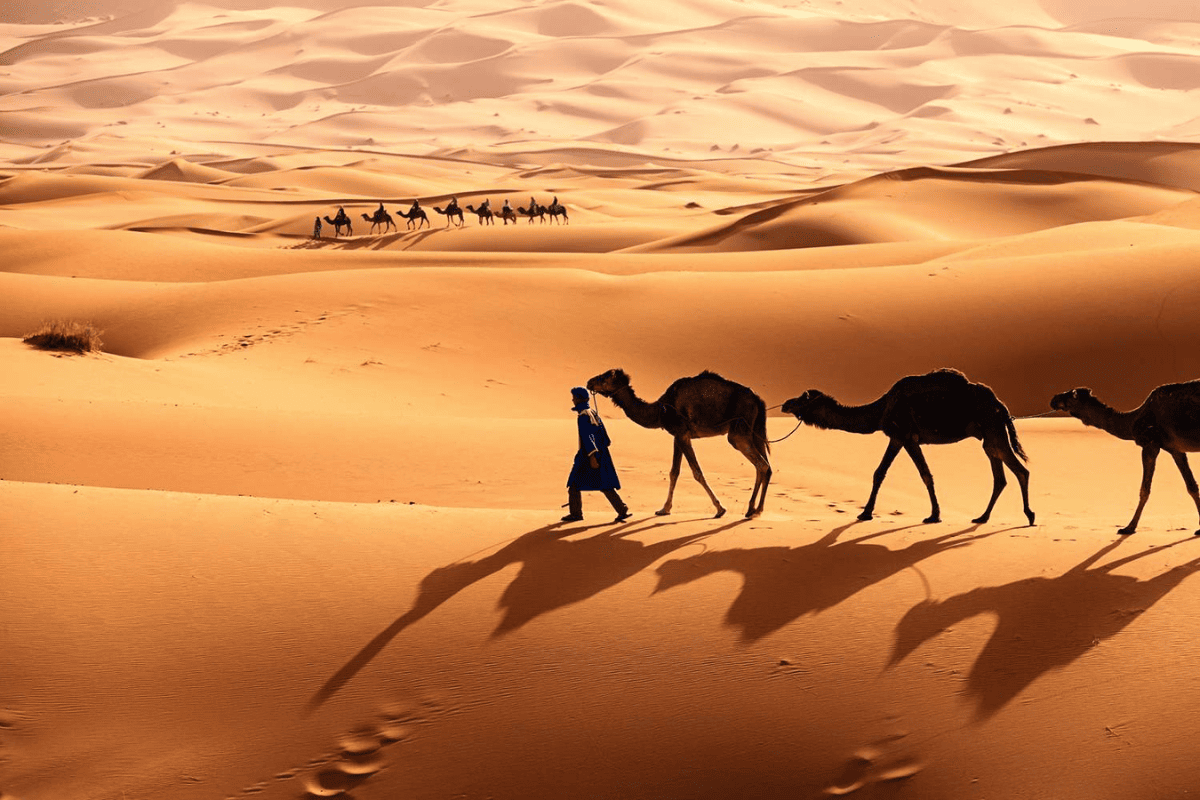
Exploring the Sahara Desert
Journeying through the Sahara unveils stunning proportions and unparalleled beauty. Spanning over 9.2 million square kilometers, this vast expanse extends across North African nations. The mesmerizing landscape of the hot desert unfolds with shifting sand dunes, creating an otherworldly picture. Moreover, crafted by the relentless wind, these golden waves contribute to a harsh yet hauntingly beautiful terrain that captivates the imaginations of all. The seamless transition from the expansive proportions to the intricate details of the shifting sands; accentuates the awe-inspiring nature of the Sahara.
However, the Sahara is more than just a breathtaking display. Foundationally it is an area of extremes, characterized by severe temperature changes. Scorching highs surpass 50 degrees Celsius during the day, while bone-chilling lows drop into the sub-zero range at night. In this challenging environment, coupled with water scarcity, a unique ecosystem has evolved and adapted to thrive. The Sahara’s dual nature, harsh yet enchanting, serves as a testament to life’s resilience in the face of relentless climatic challenges, providing a unique experience for explorers.
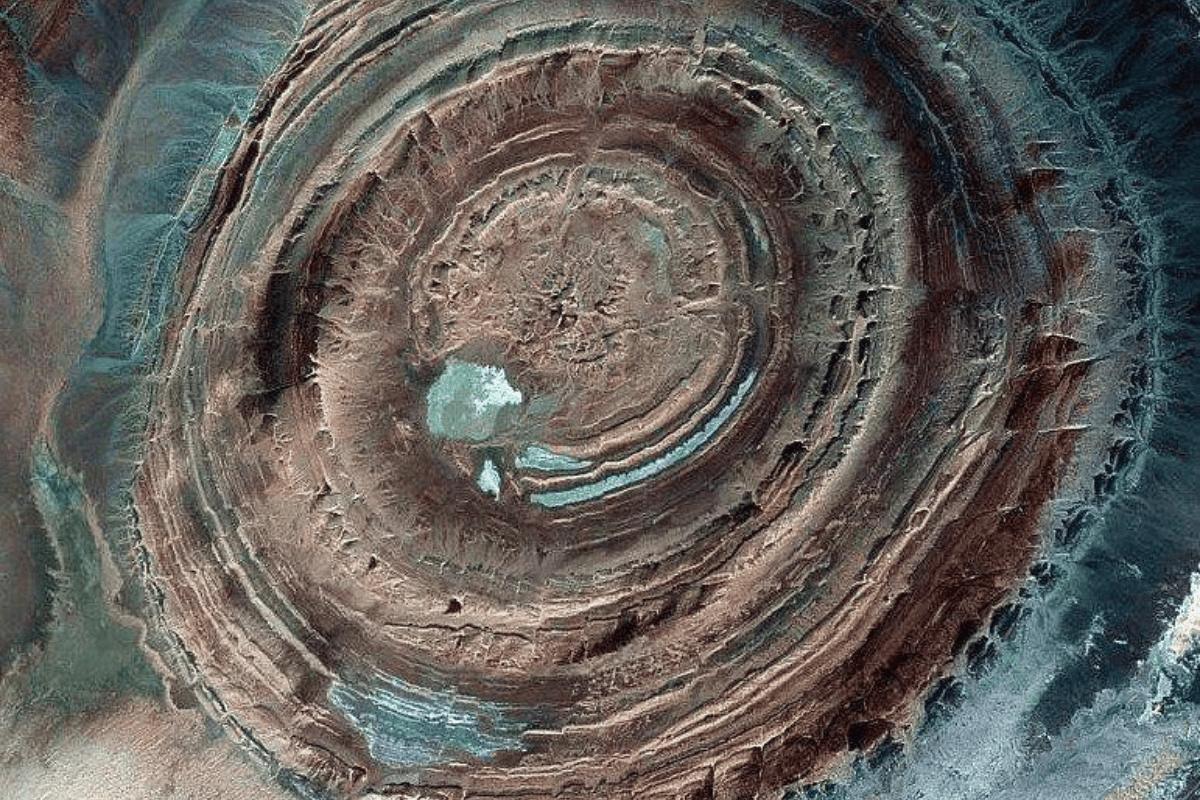
Gems of the Desert: Sahara’s Geological Mysteries
Beneath the seemingly endless sea of the Sahara’s dunes lies a fascinating geological mystery. One that challenges conventional views of this iconic desert. The discovery of remains of ancient riverbeds, hidden beneath the sands, reveals the existence of the Tamanrasset River. A silent declaration to a bygone era when water flowed through the heart of the Sahara. These hidden river channels tell a story of a vibrant past; where life flourished and intricate channels were carved into the desert floor by the flow of water. The evidence of these lost rivers beckons us to reimagine the Sahara. As more than just a desolate sea of sand, but providing a glimpse into a dynamic history where rivers sustained diverse ecosystems.
The revelation of the Tamanrasset River’s historical course leaves much to ponder. It has prompted questions about the forces that transformed this once lush landscape into the expansive desert we know it as today. These lost rivers, exemplified by the Tamanrasset; beckon us to explore the mysteries of our planet’s past and challenge what we think we know about the world’s most iconic deserts. It invites us to reconsider the Sahara’s ancient identity, prompting us to envision a time when it was a thriving landscape flowing with ancient rivers.
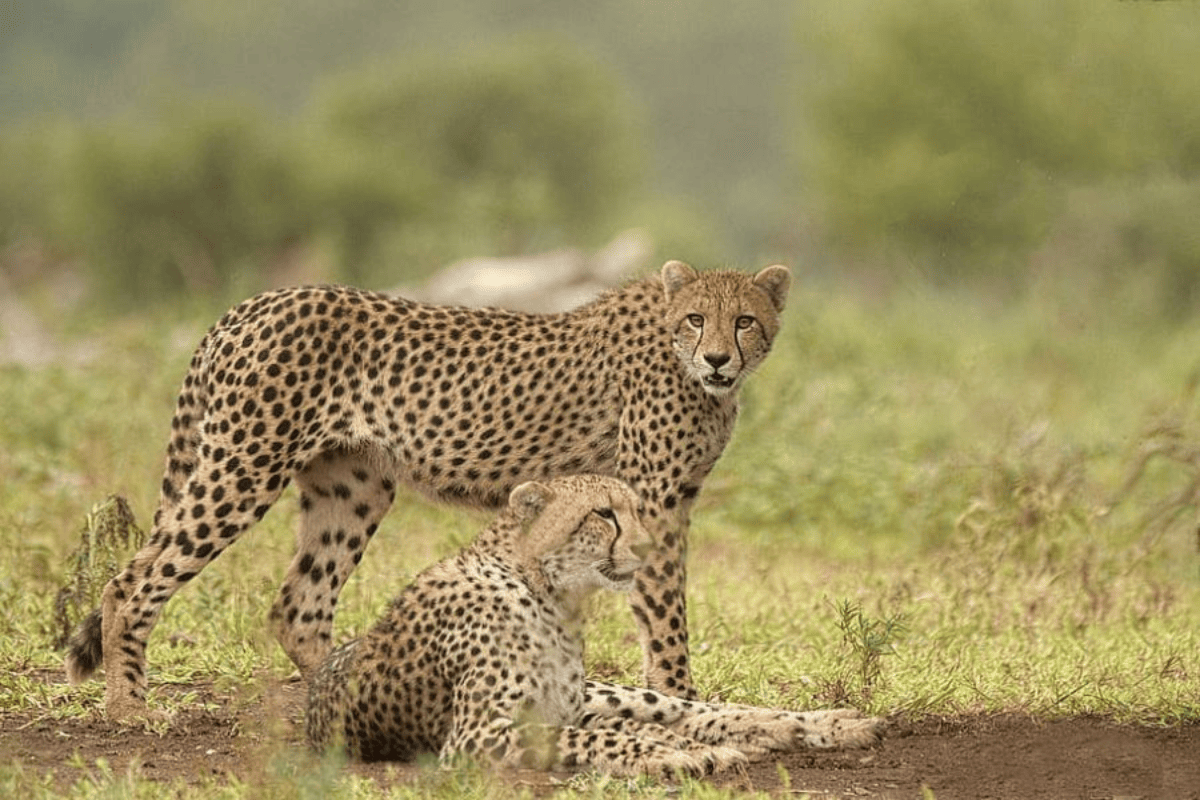
Saharan Cheetah
Tailored to withstand the harsh conditions of the desert, the Saharan Cheetah emerges as a standout species thriving in the unforgiving Sahara. Amidst the challenging environment, this elusive feline has evolved distinctive features that set it apart from counterparts in different regions of the world. Notably, the cheetah’s sleek fur seamlessly mirrors the color of the sandy terrain, offering a remarkable natural camouflage. This adaptive quality facilitates stealthy movements across the vast desert expanse, underscoring the cheetah’s adeptness in navigating its challenging surroundings. What truly underscores the Saharan Cheetah’s resilience is its exceptional ability to traverse challenging landscapes and endure harsh terrains. This capability serves as a testament to the evolutionary prowess meticulously honed over generations.
Extending its range across various North African countries, the Saharan Cheetah’s narrative of survival unfolds as a tale marked by both rarity and vulnerability. Regrettably, a mere fraction of its population endures, granting it the somber distinction of being among the most critically endangered large felines on a global scale. In response to this precarious situation, concerted conservation endeavors have been set into motion, acknowledging the delicate balance that exists between the wonders of nature and the pressing call for preservation. This imperiled species, with its graceful agility and captivating presence, serves as a poignant symbol of the intricate dance between life and survival within the formidable Sahara.
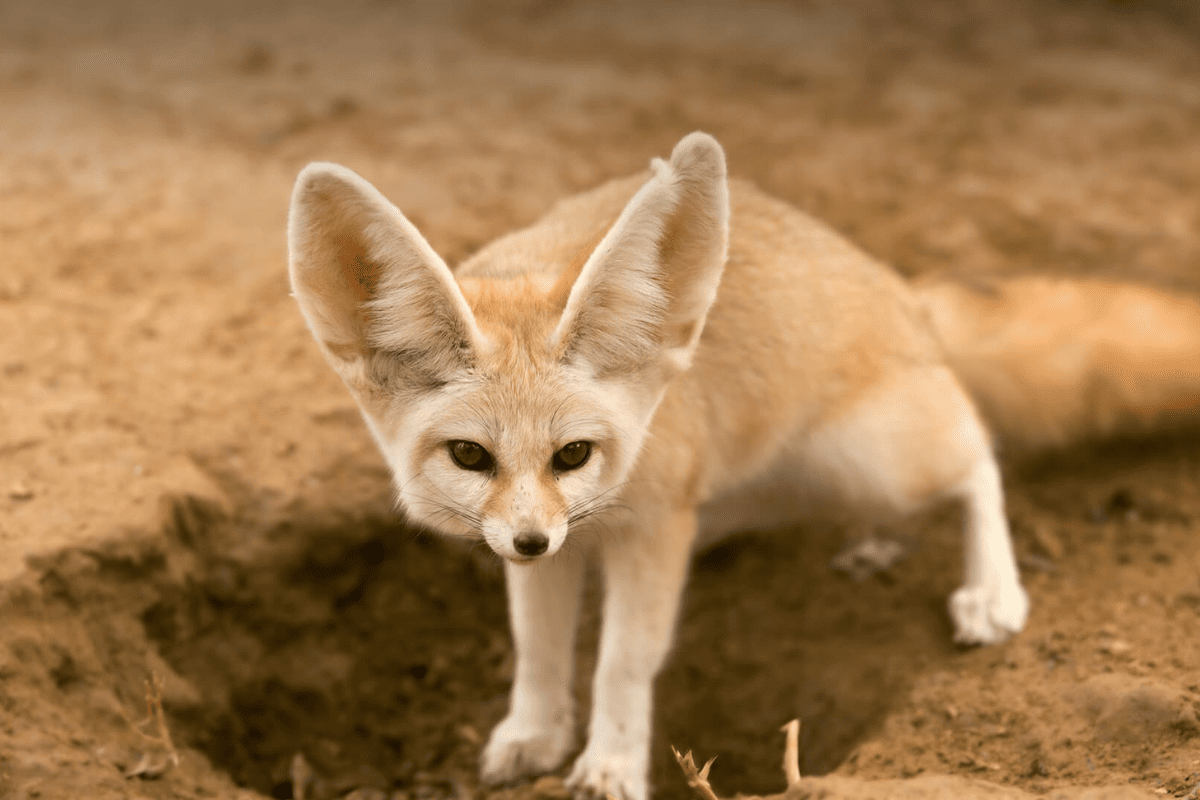
Fennec Fox
Another tiny creature, the Fennec Fox, amazes researchers and wildlife fans by thriving in its harsh, dry surroundings. Scientifically known as Vulpes zerda, this little fox is the tiniest in the fox family and stands out for its unique physical features. Its most noticeable feature is its unusually large ears, which serve two purposes: acting like radar for detecting prey and functioning as a smart cooling system in the relentless desert heat. These big ears help the Fennec Fox release excess body heat, enabling it to handle the scorching Saharan environment with impressive adaptability.
Additionally, what truly makes the Fennec Fox special is its ability to survive in an environment that’s tough for most living things. In adapting to the demanding conditions of the Sahara, these resilient and clever nocturnal creatures, the Fennec Foxes, have embraced a lifestyle that enables them to flourish specifically in the cooler nighttime. Diverging from the habits of numerous other animals, the Fennec Fox can successfully manage without direct access to free water, skillfully extracting moisture from the food it consumes.
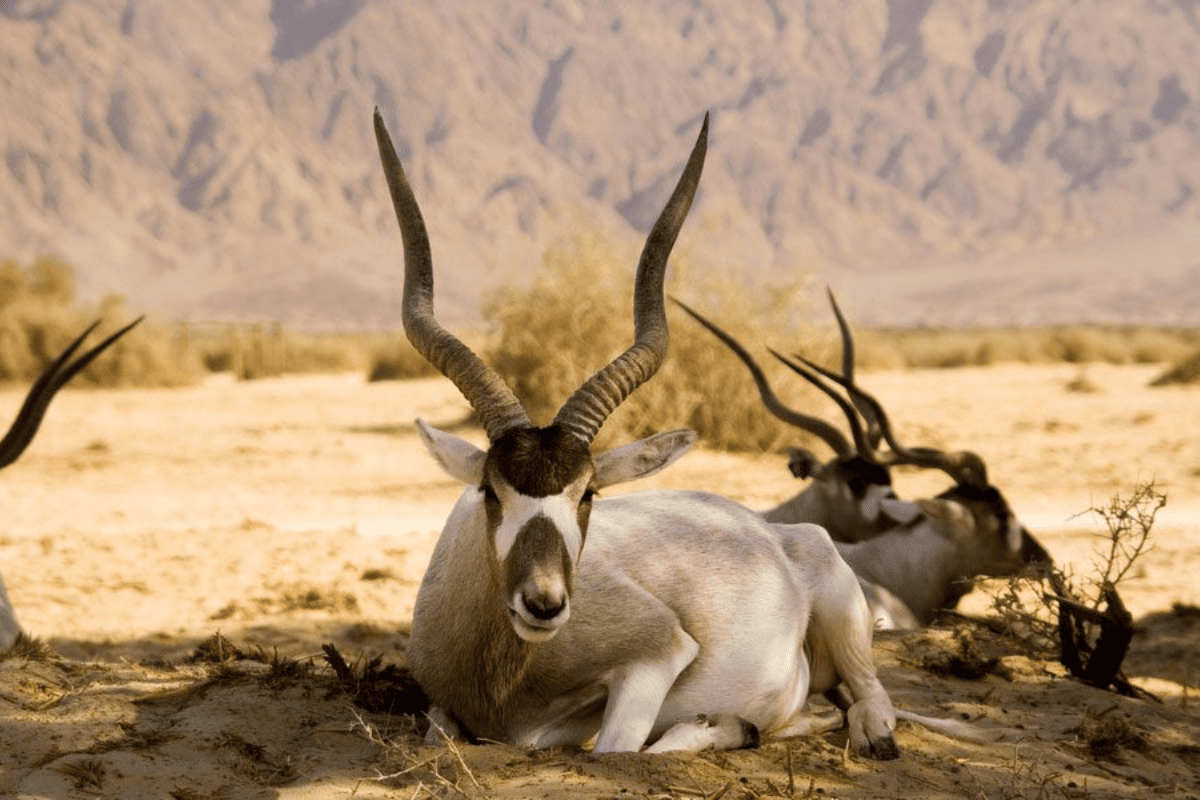
Addax Antelope
Nestled in the vast sand dunes and dry landscapes of the Sahara, the addax antelope is a tough example of nature’s ability to adapt. This rare species, native to the expansive desert, has found its own special place in one of the toughest environments on Earth. The Sahara, known for its harsh temperatures and ever-shifting sands, provides an amazing backdrop for the addax antelope’s story of survival. Their unique, spiral-shaped horns aren’t just for show; they’re a remarkable adaptation that helps these elegant creatures move gracefully through the challenging terrain.
Accordingly, what sets the Sahara-dwelling addax antelope apart is its stark difference from typical wildlife habitats. Unlike the lush, green ecosystems found elsewhere, the Sahara showcases a surreal scene where life’s toughness is front and center. These antelopes can endure long periods of drought without needing to drink water. Instead, they rely on moisture from juicy plants and wild melons to survive. Beyond their eye-catching appearance, these antelopes symbolize the delicate balance between nature and the extreme challenges it can face. As the addax antelope gracefully navigates the rolling dunes, it embodies the essence of survival against all odds, turning the Sahara into a unique stage for life unlike any other place in the world.
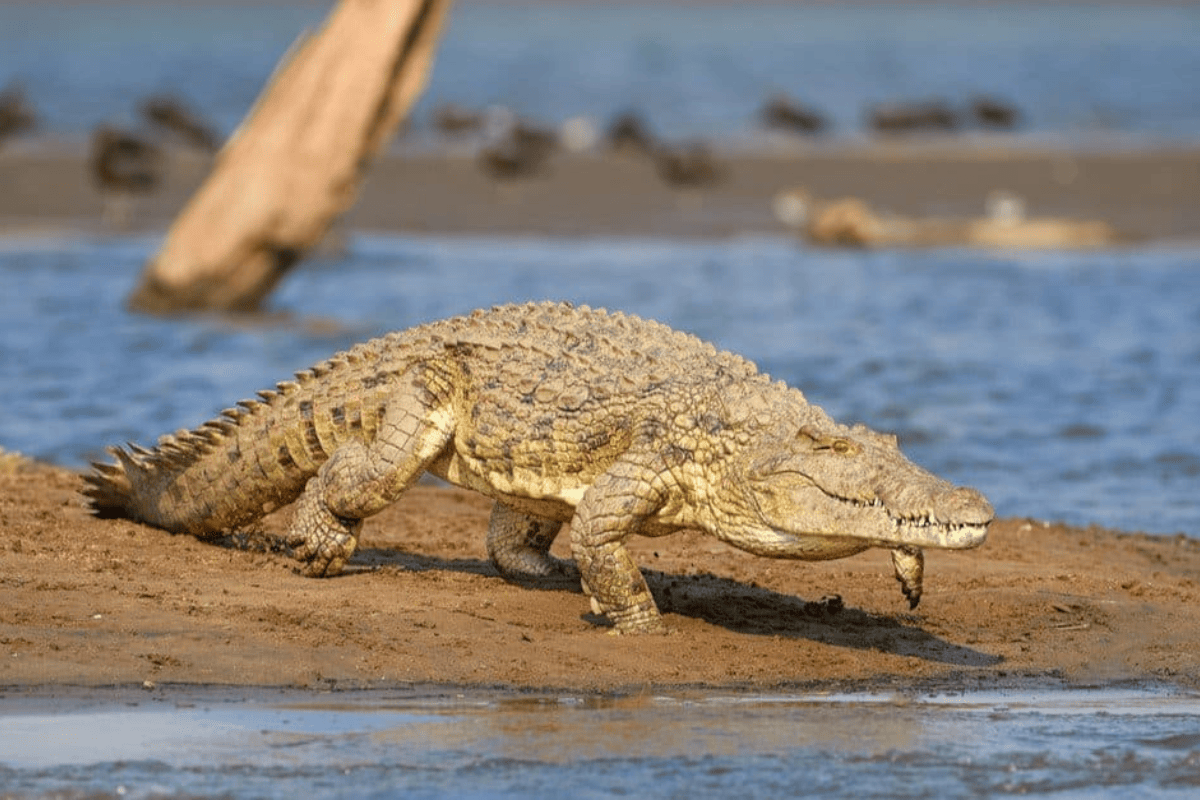
Desert Crocodile
The desert crocodile (Crocodylus suchus) is an impressive creature that flourishes in the tough Sahara environment. Unlike other crocodiles, it has adjusted to the unconventional habitat of hidden oases and seasonal water sources within the desert. Excelling in extreme conditions, the desert crocodile faces and overcomes challenges presented by scorching temperatures, scarce resources, and seemingly endless stretches of lifeless sand.
This adaptability is proof of the desert crocodile’s evolutionary skills as it navigates survival challenges in a landscape typically unsuitable for crocodiles. The Sahara becomes a unique setting where nature’s determination and adaptability come together, with these reptiles existing within isolated water pockets amid the vast sea of sand. Moreover, the desert crocodile employs specific survival tactics, such as efficient water conservation mechanisms and temperature regulation, showcasing its expertise not just in surviving but thriving in the harsh Sahara landscape.
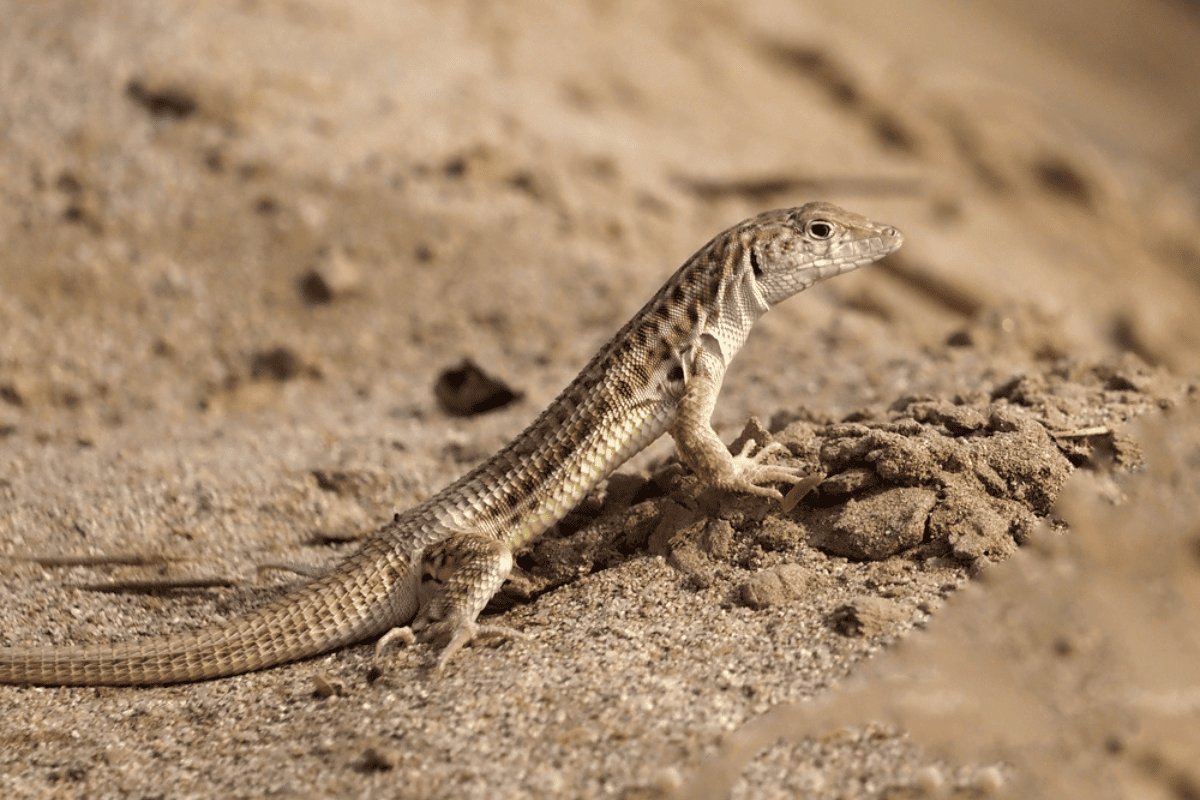
Fringe-Toed Lizard
One of the most interesting creatures in the Sahara is the fringe-toed lizard. This lizard has adapted in amazing ways to move through the tough terrain. What makes it stand out is the special scales on its toes. These scales are cleverly designed to help it move easily through the shifting sands. They reduce friction, letting the lizard glide effortlessly across the desert. This is an incredible evolutionary feature that helps it outsmart predators and quickly find food.
Nature’s toughness is evident in these rare reptiles, making them even more fascinating. They show remarkable resilience in dealing with the challenges of the dry landscape. These lizards have evolved unique ways, both in their bodies and behavior, to handle extreme temperatures and the scarcity of water. The special toe fringes help them move efficiently on loose sand, saving energy and giving them an edge in hunting and escaping predators. Moreover, their ability to burrow into cool sand lets them avoid the intense daytime heat.
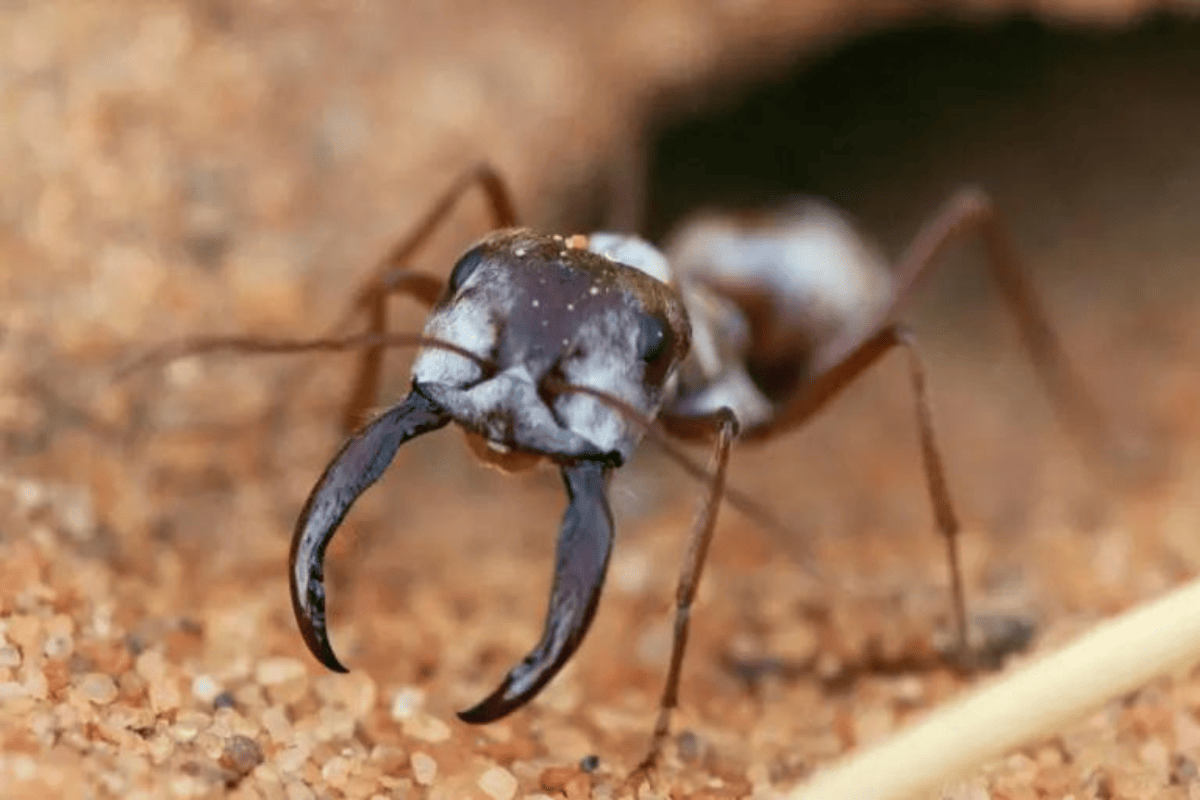
Saharan Silver Ant
In the vast Sahara Desert, the Saharan silver ant stands out as a fascinating creature that thrives in one of the toughest places on Earth. Unlike most other species that would avoid the harsh conditions, these ants show an unmatched ability to endure extreme heat. While other similar ants are active at night, the Saharan silver ants brave the intense sun, going out in the hottest part of the day to search for food on the scalding sand. Their silvery appearance, from which they get their name, isn’t just for looks—it serves a crucial purpose. This shiny coating helps them reflect sunlight, enabling them to navigate the challenging terrain without succumbing to the blazing heat.
On the other hand. What truly makes the Saharan silver ant special is its remarkable ability to handle extreme temperatures, often surpassing 50 degrees Celsius (122 degrees Fahrenheit). This incredible adaptation is possible thanks to their unique long legs, which lift their bodies above the searing surface, minimizing direct contact with the scorching sand. Additionally, these ants have developed specific heat-shock proteins that shield their essential cellular functions from the harsh temperatures.
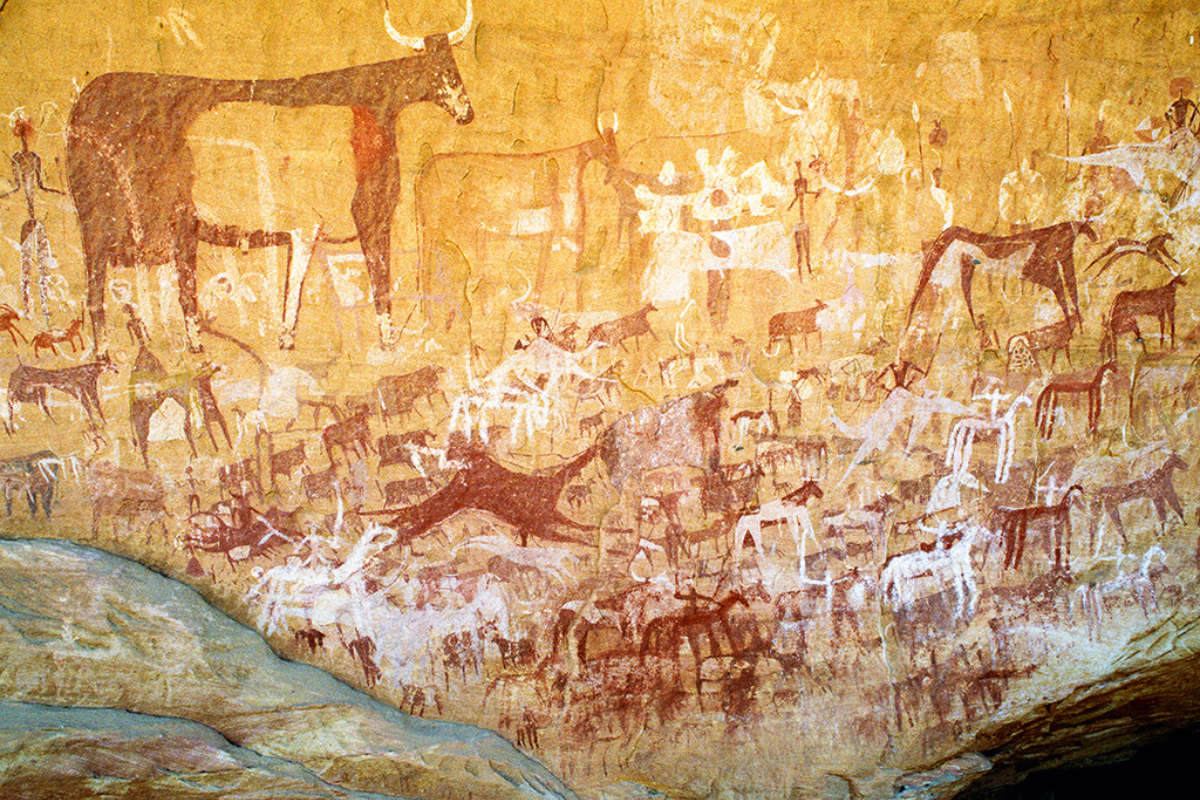
Rock Art In The Desert
The Sahara tells an interesting story through the mysterious Tassili n’Ajjer. A place that shares tales of human history using captivating rock art. The rock art reveals ancient drawings of prehistoric life, giving us a colorful window into the traditions and activities of ancient societies that thrived in the challenging desert. Carved onto worn rocks, these incredible artworks hold the weight of thousands of years, tracing their origins back to ancient times.
The rock art of Tassili n’Ajjer is an unmatched testament to the past, offering deep insights into the lives of our ancient ancestors. It showcases scenes of everyday life, ceremonial rituals, and the various animals that once lived in the region. These artistic depictions are powerful reminders of the enduring human spirit and creativity. Despite the passage of time that has worn down the stones and landscapes, these petroglyphs and pictographs continue to captivate archaeologists and visitors alike. They provide a tangible connection to the distant past, offering a unique look into the development of human civilization amidst the harsh beauty of the Sahara.

Desert Roses
In the Sahara desert, amazing things happen in nature, and one of these is the creation of “desert roses.” Accordingly, these are not your typical flowers. Instead, they’re fancy mineral structures formed by mixing sand, water, and minerals. Picture it not as flower petals but as nature’s impressive sculptural display, telling a beautiful story about how the elements dance together in the desert.
The importance of desert roses chiefly lies in how they show the Sahara’s strength and artistic ability in tough conditions. Despite slowly evolving through the careful arrangement of mineral crystals, these formations have a captivating charm that grabs your attention. Essentially, desert roses reveal the Sahara’s geological story, displaying intricate details and a variety of colors. It’s like nature saying, “Even in the wildest places, unexpected beauty can appear.” So, when you’re exploring the desert, keep an eye out for these incredible mineral wonders,they represent nature’s clear statement of creativity.
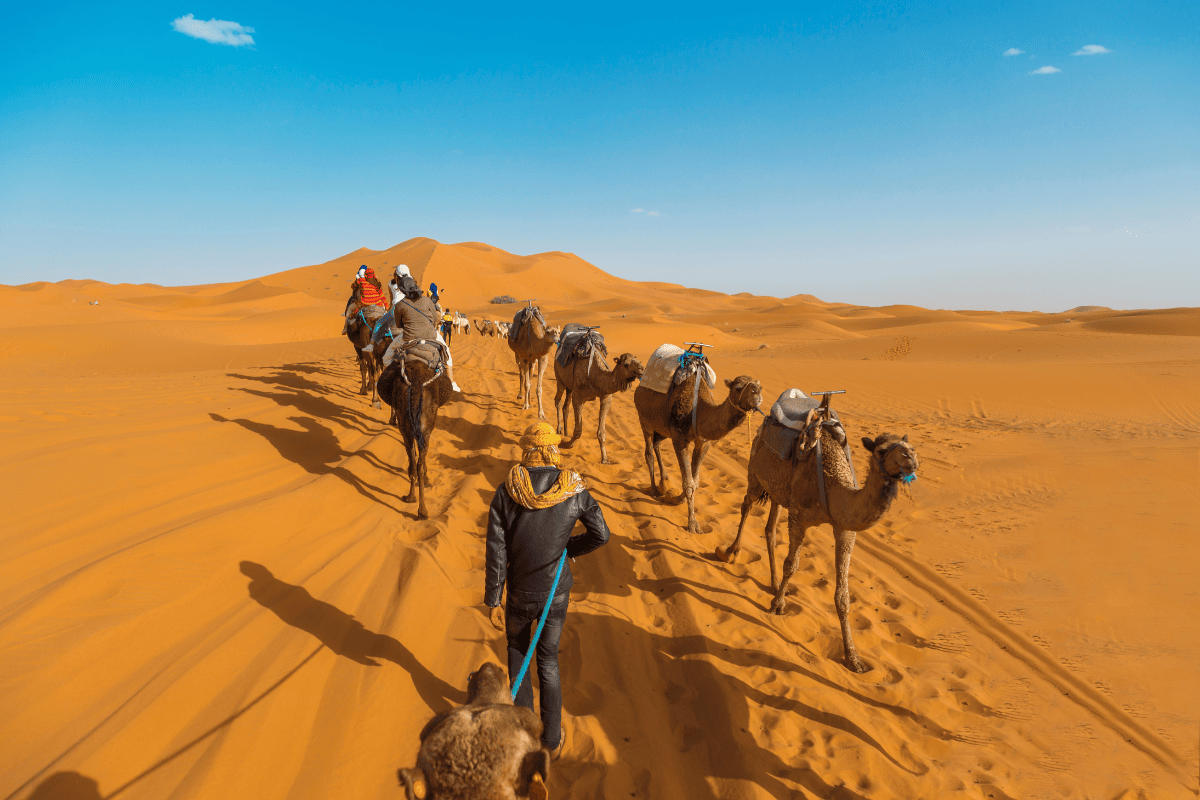
Caravan Routes
In history, the Sahara Desert isn’t just a tough barrier; it’s also a vital pathway teeming with the life force of trade. The legacy of caravan routes crossing the Sahara brings to mind images of camels carrying precious treasures. Picture nomadic traders navigating through the dunes on risky journeys across the dry landscape. This historical story shows the Sahara as a crucial part of ancient trade routes, where camel caravans acted as the vital link connecting different regions.
These caravan routes are important not only for moving goods but also for the cultural exchanges that happened along the shifting sands. Gold from West Africa, salt from the depths of the Sahara, and colorful textiles from the Mediterranean, these items were like threads weaving a complex network of economic and cultural ties. The resilient nomadic traders who faced tough conditions made a lasting impact on Sahara’s history, creating a network of routes that stitched together distant civilizations.
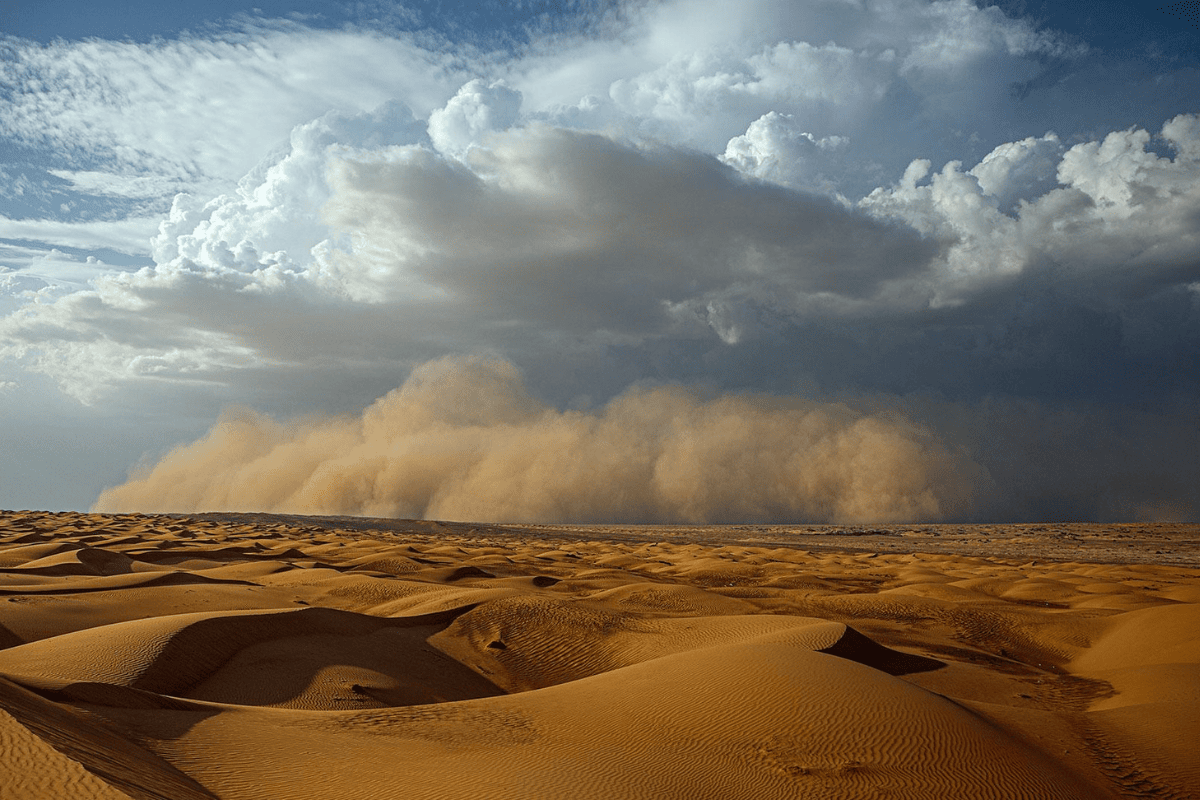
Sirocco Winds
Aboce the vast theater of the Sahara, nature orchestrates a captivating dance with the Sirocco winds, a climatic phenomenon that gives the region its dynamic character. Known for its intense heat and unpredictable nature, the Sirocco wind emerges as a powerful force, reaching hurricane speeds that reshape the desert landscape. This meteorological performance comes to life as the wind carries massive amounts of sand and dust across the Sahara, creating a spectacle that transcends borders and challenges geographical limits.
And so, the Sirocco winds are more than just atmospheric currents; they embody the elemental strength of the Sahara. Simultaneously carrying the very essence of the desert, these winds become agents of change, molding dunes and reshaping landscapes as they travel. The influence of the Sirocco extends well beyond the Sahara, coloring neighboring regions with the warm hues of transported sands. This atmospheric dance, marked by the desert’s hot breath, stands as evidence of the Sahara’s ability to surpass its own boundaries, leaving an enduring mark on the broader canvas of the Earth’s climatic symphony.
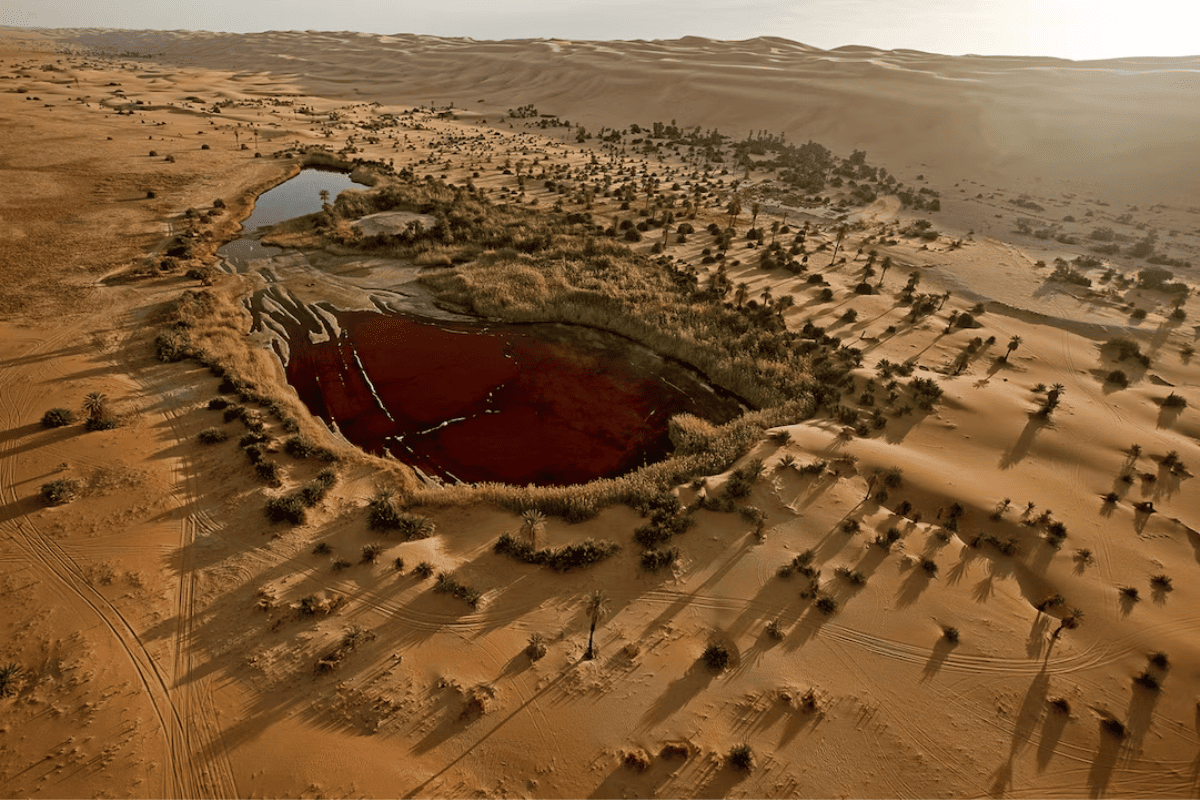
Ancient Lakes of the Desert
Underneath the seemingly endless stretch of dry sands in the Sahara, there’s an interesting chapter in Earth’s history. Additionally revealing signs of ancient lakes that once held life in areas even larger than what we see today. These lost water worlds, now buried under shifting dunes, used to be crucial oases supporting diverse ecosystems and bustling human communities. The remains of this watery past share a story about a Sahara that was significantly different from the desolation we picture today.
Over countless ages, these ancient lakes were more than just illusions. They were vibrant reservoirs of life, nurturing a variety of plants and animals. These ecosystems provided sustenance for both wildlife and early human societies. The archaeological evidence left behind by these ancient lakes serves as a powerful reminder of the Sahara’s ever-changing appearance. Delving into this submerged history reveals a Sahara that swung between extremes, transitioning from lush, life-sustaining water habitats to the harsh dryness we now associate with it. The traces of these ancient lakes, concealed beneath the surface, provide a peek into the Sahara’s past, where water once shaped a different story in the heart of the world’s largest hot desert.

Saharan Nomadic Cultures
Unbeknownst to many, nomadic cultures thrived for centuries in the Sahara, embracing a unique way of life. Shaped by desert challenges and beauty, these communities, known for adaptability and mobility, navigate with portable dwellings and ancestral wisdom. Their survival relies on communal cooperation, familial ties, and shared knowledge to conquer the Sahara’s harsh realities.
Nomadic Saharan cultures express identity through traditions, rituals, and oral histories, showcasing resilience. Their ecological awareness, seen in sustainable practices, maintains balance with the desert ecosystem. Contemplating the Sahara’s vastness, these cultures offer a captivating study in adaptability, community, and the preservation of human history. They contribute to the Sahara’s essence, defining a dynamic expression of identity in a vibrant mosaic.
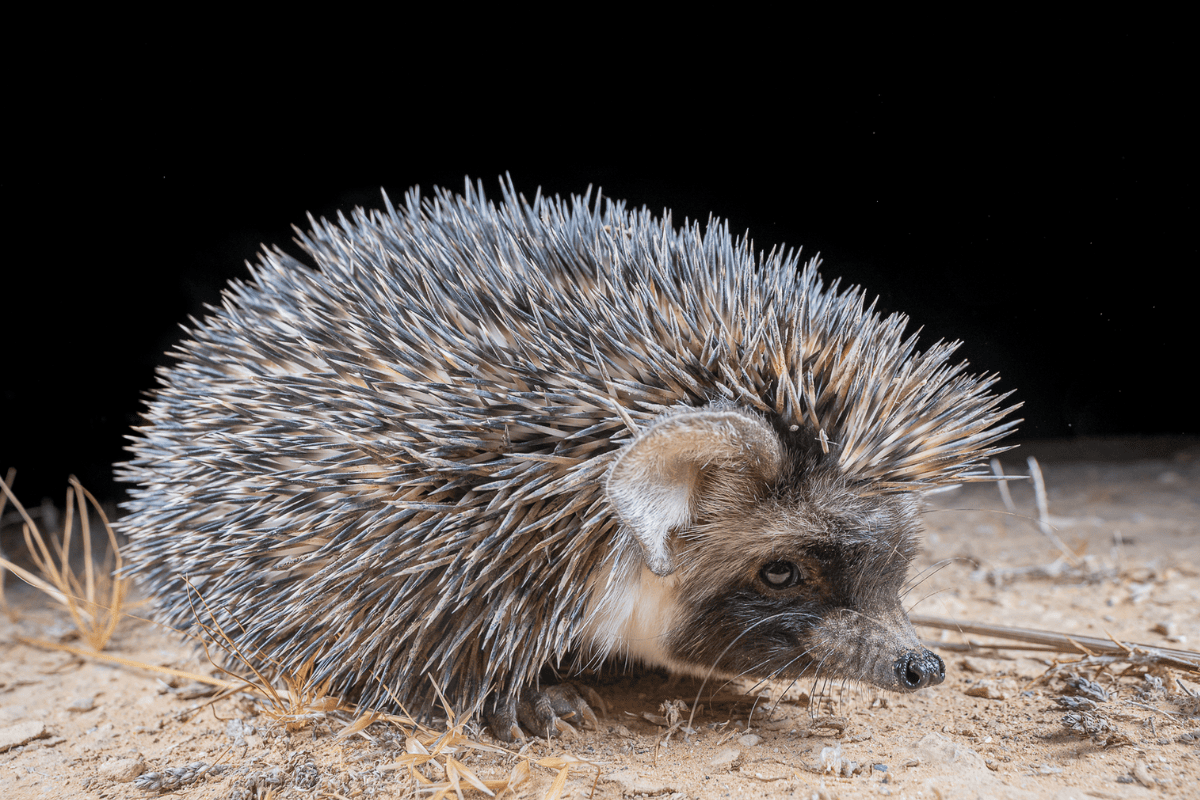
Saharan Hedgehog
In the Sahara, an unexpected resident, the Saharan hedgehog, stands out as a remarkable survivor. On account of adapting to the tough desert conditions, this creature has developed a spiky exterior and has developed unique traits to flourish in an environment where resilience and resourcefulness are essential. By burrowing during the day and using specialized feet to move across shifting sands, the Saharan hedgehog skillfully avoids the intense heat and navigates the challenges of its arid home.
Despite its small size, the Saharan hedgehog plays a crucial role in the delicate balance of the desert ecosystem. Its resourcefulness extends to a varied diet, encompassing insects, plants, and small vertebrates. This additionally showcases its adaptability, a key factor for survival in a landscape where resources are scarce. As a resilient creature capable of enduring the extreme Sahara conditions, it serves as proof of nature’s ingenious solutions. Moreover, it plays a vital role in sustaining the intricate web of predator-prey relationships that define life in one of the world’s toughest environments.
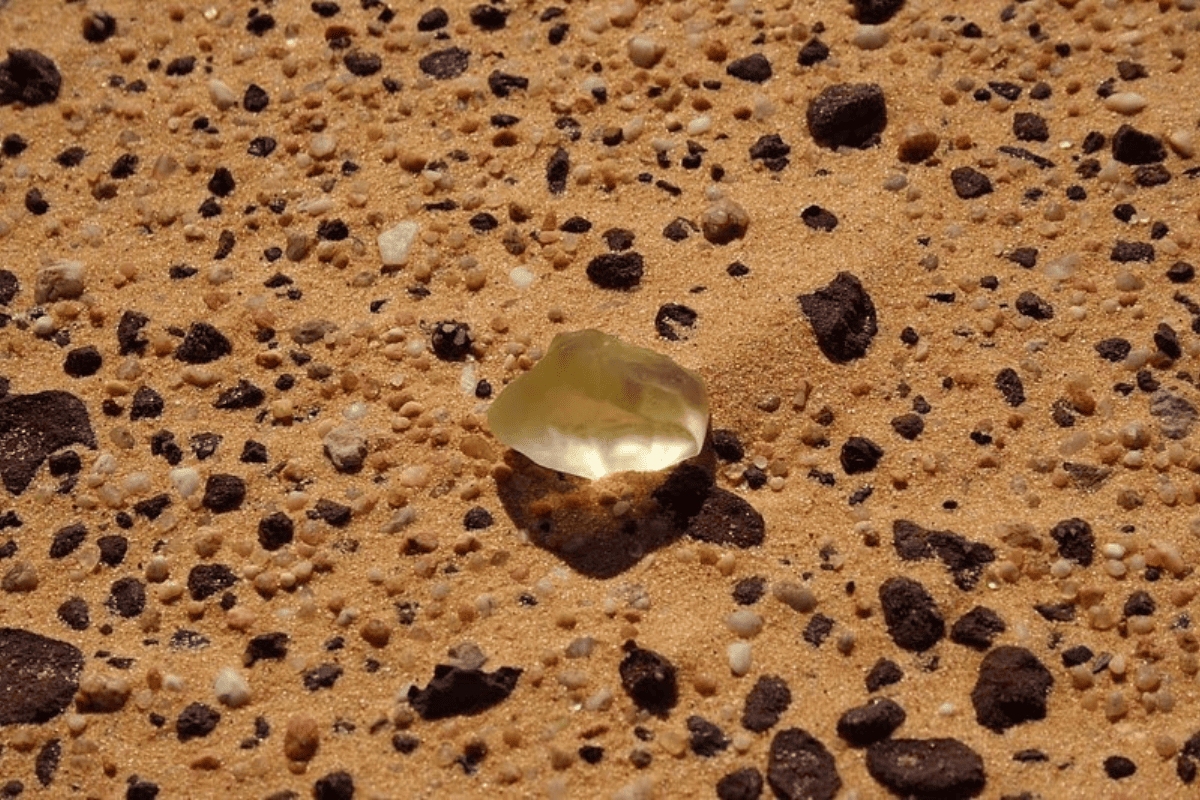
Libyan Desert Glass
In the midst of Egypt’s extraordinary Great Sand Sea, there’s a quiet mystery waiting to be uncovered: Libyan Desert Glass. Scattered across the dry landscape, these puzzling bits of yellow-green glass share a story told in whispers from the stars. They’re thought to have come from a collision in space. These glass fragments are like ancient souvenirs from a time when a meteorite crashed and created pieces of glass that now decorate the desert like a celestial mosaic.
Moreover, the appeal of Libyan Desert Glass isn’t just in its mysterious origins but also in the captivating story it paints in the sand. It’s believed to be the result of a meteorite hitting millions of years ago. These glass pieces carry the echoes of cosmic forces that once shaped the Earth’s surface. As scientists and enthusiasts explore the vastness of the Great Sand Sea, finding these glass pieces ignites a sense of awe and curiosity. It beckons us to reflect on the deep connections between our planet and the cosmos. Libyan Desert Glass, with its vibrant colors and cosmic tale, encourages us to ponder the ancient secrets lingering beneath one of the world’s most fascinating deserts.
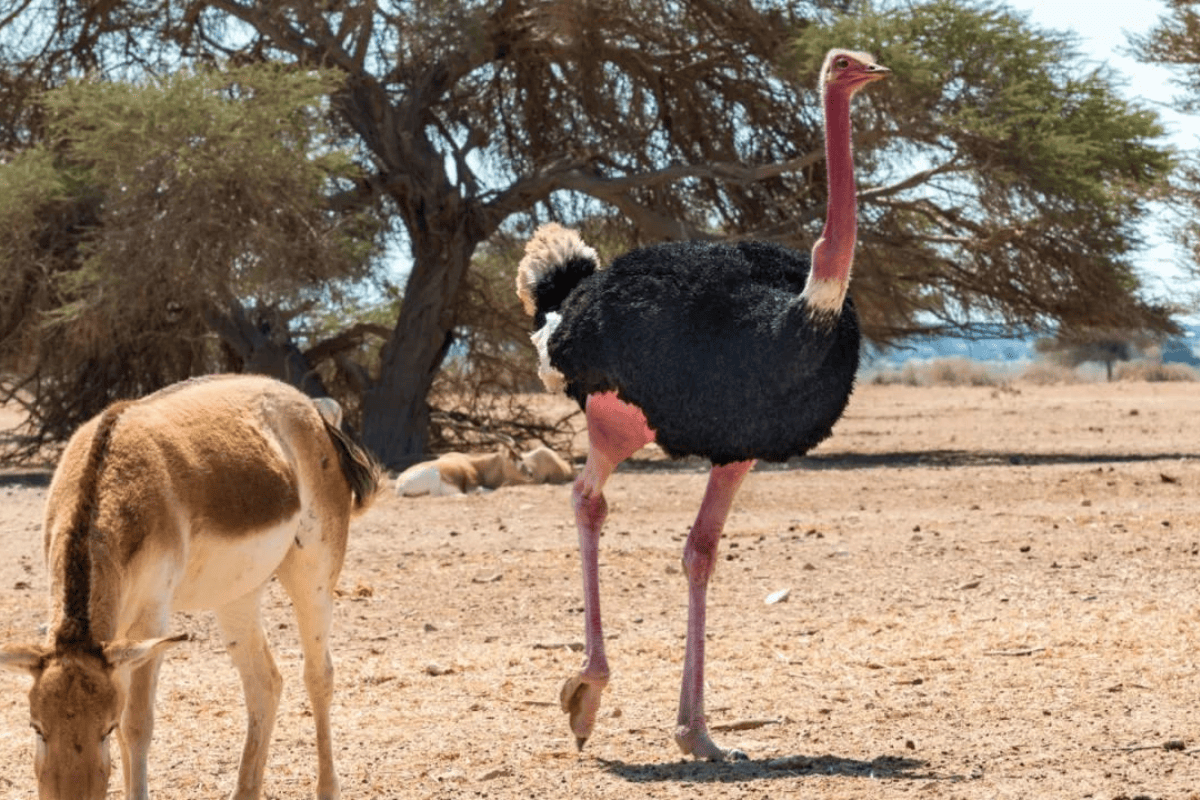
Saharan Ostrich
Exploring the expansive Sahara unveils a truly awe-inspiring creature, the North African ostrich, scientifically identified as Struthio camelus camelus. Standing as the largest living bird globally; this majestic animal represents a remarkable example of adaptation within one of the planet’s most challenging terrains. Notably, its powerful legs are finely crafted for swift running, showcasing a remarkable feat of evolution. Moreover, the unique reduction in feather coverage further exemplifies the ostrich’s exceptional adaptation strategies. In essence, this incredible creature embodies the epitome of evolution; sculpted by the relentless forces of the formidable desert landscape.
Furthermore, beyond their physical adaptations, Saharan ostriches display smart behavioral strategies. Always on the move in search of food and water, they adopt a nomadic lifestyle. Doing so allows them to make the most of the unpredictable nature of desert resources. Their nomadic habits, coupled with a diet including seeds, insects, and vegetation, showcase their resourcefulness. Chiefly in securing sustenance in an environment where food is scarce and widely scattered. The Saharan ostrich thus stands as a testament to nature’s cleverness, with these birds demonstrating a harmonious blend of physical adaptations and strategic behaviors that enable them to thrive in the challenging Sahara.

Desert Monitor Lizard
In the sun-drenched expanses of the Sahara, a formidable presence silently navigates the arid terrain; the desert monitor lizard. As a testament to the reptilian rulers of the desert, these creatures can attain lengths of over a meter. With this size, they are able to establish themselves as a prominent figure in the intricate ecosystem of Sahara’s wildlife. With its streamlined body and keen senses, these lizards navigates the arid terrain with remarkable efficiency. Their elongated tail and sharp claws facilitate both movement and burrowing. This allowes the lizards to seek refuge from the scorching desert sun. Furthermore, these lizards have evolved a sophisticated respiratory system that enables them to extract water from the air. This ability is a crucial adaptation for survival in an environment where water sources are scarce and unpredictable.
Whenever the desert sun casts its relentless rays, the desert monitor lizard unveils its prowess as a skilled climber. Often discovered basking on rocks or nestled within the branches of desert vegetation. These lizards often elevate themselves to vantage points. These offer not only respite from the scorching ground but also a strategic advantage for spotting prey. With a blend of sleek agility and impressive size. The Sahara’s monitor lizard becomes a living embodiment of survival. In an environment where mastery of both ground and elevated domains is a requisite. In the ever-shifting sands of the desert.

Saharan Desert Dust Plumes
Across the canvas of the Sahara. A natural spectacle unfolds as large dust plumes. Propelled by the formidable Harmattan winds, these plumes span thousands of kilometers across the Atlantic Ocean. Additionally, Saharan dust plumes are born from the relentless winds sweeping across the desert; carrying with them fine particles of sand and mineral dust. These atmospheric currents elevate the microscopic particles into the air. As a result, creating expansive plumes that can extend across continents and even traverse oceans. The prevalence of these dust plumes underscores the Sahara’s influence on global weather patterns. Accordingly the transported particles impact atmospheric conditions and contribute to phenomena such as the creation of vibrant sunsets.
As these dust plumes traverse the Atlantic, they carry with them a payload of essential minerals from the Sahara. In doing so, this transforms the winds into fertilizing agents for the Amazon basin. Additionally, the seemingly barren particles, lifted from the African desert, become conduits of life as they settle over the rainforest. Further nourishing the soil and providing vital nutrients for the intricate web of flora and fauna. In this grand intercontinental exchange. The Saharan dust plumes serve as messengers of ecological interconnectedness. The Amazon owes a debt of gratitude to the winds that traverse the Sahara. They bring with them not only dust; but also the sustenance that fosters life in one of the world’s most biodiverse regions.
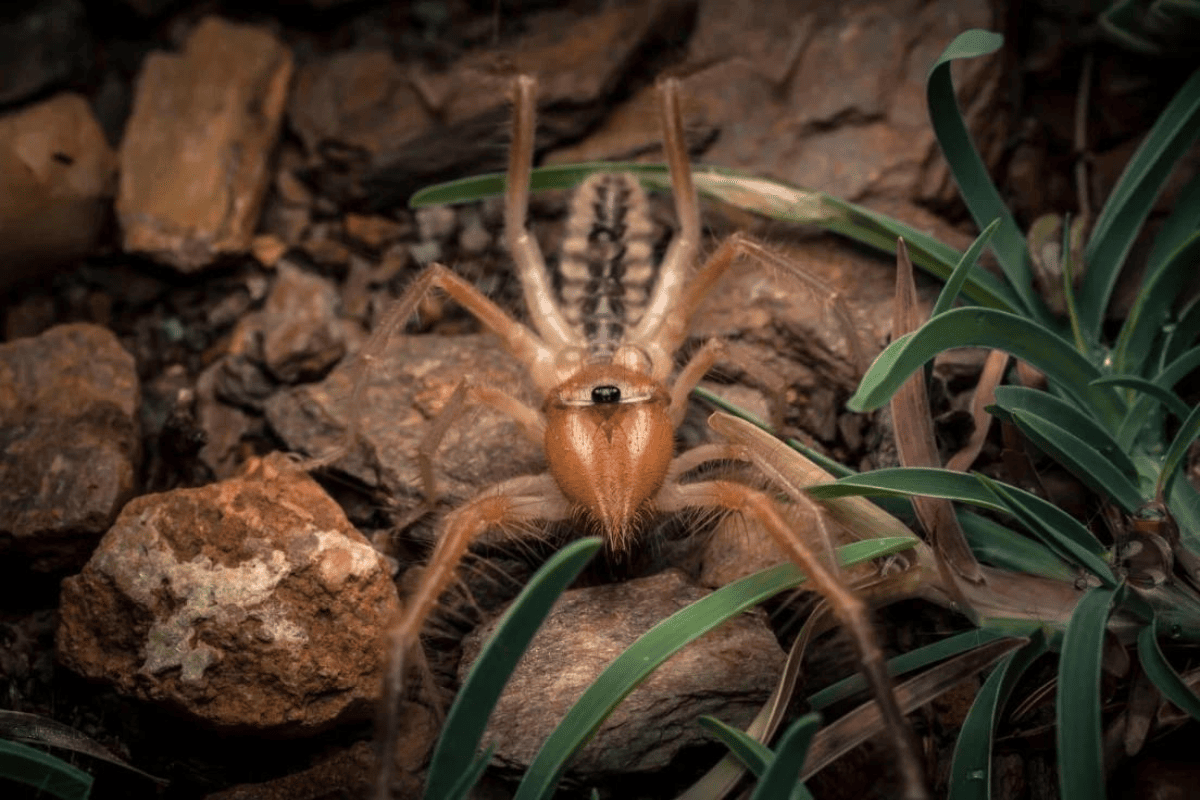
Camel Spiders:
Skittering across Sahara’s ever-shifting landscapes, camel spiders, also called wind scorpions or solifuges, stand out as enigmatic arachnids uniquely adapted for desert survival. Characterized by formidable jaws and robust legs, these creatures, belonging to the order Solifugae, evoke trepidation with their appearance. Contrary to their name, camel spiders aren’t true spiders; But have evolved features enabling them to thrive in the challenging desert environment. Remarkable speed allows swift traversal of the sandy terrain, and nocturnal habits help them evade scorching daytime temperatures by seeking shelter.
Despite their intimidating appearance, camel spiders aren’t venomous to humans. Instead, they play a crucial role in the Sahara’s ecological balance by preying on insects and small creatures. Additionally, their predatory nature and ability to extract moisture from food contribute to their adaptation to the water-scarce conditions of the desert. In essence, camel spiders exemplify life’s intricate evolution to endure and thrive in the Sahara’s extreme conditions.
Where Do We Find This Stuff? Here Are Our Sources:
Exploring the Sahara:https://www.britannica.com/place/Sahara-desert-Africa
Sahara’s Geological Mysteries: https://www.iflscience.com/the-eye-of-the-sahara-a-geological-mystery-staring-into-space-67179
Saharan Cheetah: https://www.zsl.org/what-we-do/species/northwest-african-cheetahs
Fennec Fox: https://www.nationalgeographic.com/animals/mammals/facts/fennec-foxFennec Fox:
Addax Antelope: https://www.animalia.bio/addax
Desert Crocodile: https://a-z-animals.com/blog/discover-the-incredible-desert-crocodiles-that-live-in-the-sahara/
Fringe-Toed Lizard: https://www.biologicaldiversity.org/species/reptiles/Mojave_fringe-toed_lizard/index.html
Saharan Silver Ant: https://www.bnl.gov/newsroom/news.php?a=111737
Rock Art: https://www.metmuseum.org/toah/hd/tass/hd_tass.htm
Desert Roses: https://www.interestingfacts.org.uk/what-is-the-sahara-desert-rose/
Caravan Routes: https://www.metmuseum.org/toah/hd/gold/hd_gold.htm
Sirocco Winds: https://www.britannica.com/science/sirocco-wind
Ancient Lakes: https://www.americanscientist.org/article/ancient-lakes-of-the-sahara
Saharan Nomadic Cultures: https://www.britannica.com/place/Sahara-desert-Africa/People
Saharan Hedgehog: https://animalia.bio/desert-hedgehog?custom_list=364
Libyan Desert Glass: https://kalifano.com/blogs/stories-of-kalifano/what-is-libyan-desert-glass-and-how-does-it-form
Saharan Ostrich: https://saharaconservation.org/north-african-ostrich/
Desert Monitor Lizard: https://animalia.bio/desert-monitor?taxonomy=990
Saharan Dust Plumes: https://www.nationalgeographic.com/science/article/concerned-saharan-dust-plume-crucial-to-ecosystem
Camel Spiders: https://www.nationalgeographic.com/animals/invertebrates/facts/camel-spider
